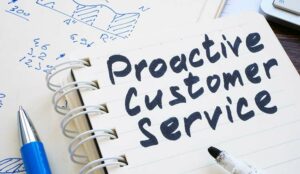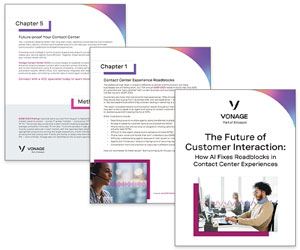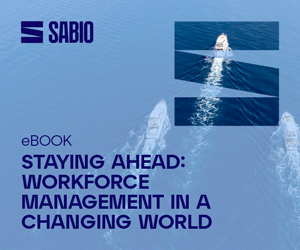We define what is meant by proactive customer service, before sharing considerations, challenges and examples of how you can make it work for your organization.
What Is Proactive Customer Service?
A simple definition of proactive customer service is that it is a form of customer support where an organization makes the first move to help the customer, preventing them from calling in to the contact centre.
To develop a proactive customer service strategy, we need to think about:
- What matters most – i.e. what are our customers’ priorities? We can find these through customer-driver insight.
- When it matters – i.e. where in the customer journey can we provide an answer, before the question is asked?
- How can we fulfil this – i.e. which channels will we use for proactive messaging and what wider impact will this have on our organizational culture?
While this can seem like a lot to consider, reaching out to a customer and solving a problem before they ask, or perhaps even realize, is a great method to lower friction in customer journeys and customer effort overall. It also helps to reduce contact centre demand.
Customer Care Tends to Be Reactive, Not Proactive
It is becoming more common for contact centres to become proactive in anticipating customer needs and meeting them early. However, many of us still sit tight and focus on responding to questions when the customer asks.
There is little wrong with doing this, but is it really the best approach?
It certainly seems the most basic approach, but saying sorry after the incident creates more work for contact centre in the long run than if we were to take on one of the following three approaches:
- Active Customer Service – Informing the customer as soon as something comes to light, e.g. There is a delay. Here’s how we are handling it.
- Proactive Customer Service – Informing the customer before something comes to light, e.g. We need to switch your water off.
- Pre-Emptive Customer Service – Informing the customer of changes that you’ve made in the past, telling them how the changes will benefit them, e.g. We’ve changed for your future benefit.
While many companies that are looking to change are choosing to be proactive, you can use elements of each of these approaches within your overall customer service strategy.
3 Things to Consider Before Going Proactive
While we will later present some great use-cases of how best to implement proactive customer service, there is a lot to think about before designing your strategy.
Here are three key considerations that you must make beforehand.
1. Are You Ready to Drive the Proactive Customer Support Across the Business?
There is a customer requirement that a proactive customer service interaction can support and improve. But being proactive will also help us to improve operationally.
How? Because it will help us to be better informed to understand what the customer’s next move is.
“While there is a tendency, because the technology is there, to go to market a little sooner than the rest of the organization is ready to support, we need to remember that being proactive will impact the entire customer journey,” says Christopher Brooks, a Customer Excellence Consultant at Clientship.
So, we need to create proactive rules within the customer journey map, which every department can see and consider how this change will impact them.
With this in mind, we need to consider if our customer journey maps are ready to become operationally useful, as many are still carried out by external agencies and this mindset can carry into the rest of the organization.
2. Is Proactive Service Right for Your Customer Experience Model?
If you are an organization that is well known for recovering issues with customers and it’s a way that you actually retain customers – proactive customer service could work against you.
Proactive customer service is not a one-size-fits-all model, and some organizations actually like to be reactive, so they can openly engage with customers and blow their socks off in the process.
Alternatively, if your organization doesn’t look to build relationships with customers – and customers don’t necessarily want a relationship with you – sendong lots of proactive notifications could become overkill.
However, if your long-term plan is to build frictionless customer journeys while securing long-term customer loyalty, proactive customer service might just be what you’re looking for.
3. Are You Prepared for the Cultural Shift?
Sometimes moving to proactive customer service is very impactful in terms of culture, not just for the contact centre, but for the rest of the organization and how you manage data.
If you take a company within a utility industry, for example, they will have likely moved into smart metering, which means that the number of data points that they have – compared to what they used to have – is significantly different. This allows them to be proactive.
Perhaps you can think about Thames Water; they have 375,000 smart meters installed. Previously, that would have meant two physical meter readings a year and related calls into customer service.
Now with the capability of five billion real-time data feeds through the smart meters, there is so much more data, and algorithms can be much more predictive.
“With more data to work from, we can better assess customer needs. However, the capability to manage that and deal not only with the proactive nature of sending out alerts, but also with the customer interaction on the back of it is a huge change,” says Christopher.
With this in mind, one key consideration is if you, as an organization, are ready for that.
The Benefits of Proactive Customer Service
The heart of knowing what you want to deliver, in terms of proactive customer service, lies initially in which benefits you want to deliver for your customers.
There are also benefits that you will deliver to your organization if you get your proactive customer service strategy right.
With this in mind, Christopher has compiled two separate lists of potential benefits for both your customers and your organization that a proactive customer service strategy could bring.
Customer Benefits
- Be better informed
- Have more control over choice
- Develop respectful relationships
- Change plans accordingly
- Create a new opportunity
- Manage cascading impact
- Consider emotional response
- Increase confidence in contact
- Increase confidence in experience
- Increase confidence in brand
Company Benefits
- Reduce cost to serve
- Demonstrate empathy
- Mitigate consequential compliance risk
- Mitigate consequential reputation risk
- Increase satisfaction
- Collect more data
- Increase CX touchpoint engagement
- Deliver personalized message
- Optimize technology as channel of choice
4 Mistakes to Avoid With Proactive Customer Service
Proactive customer service can be tricky to get right and, in order to gain some of the benefits above, some brands have rushed into implementing a strategy.
In doing so, mistakes have been made, and here are four key examples of such errors.
1. Not Showing Customers the Added Value
We need to consider if proactivity has an impact on our ability to be relevant and valued by our customers, remembering that customers will leave if they no longer recognize the value that they receive.
Take a classic example of a pothole in the road. If we cover it with planks, it’s all very well and good, because the user can see what we have done, the positive impact that we’ve made, and it’s easy to understand the benefit of it.
But if that road gets repaired smoothly, you can’t see that there was a problem there or appreciate the effort that went into repairing it. So, how can we, as the customer, value what’s happened?
This example came from Christopher, who says: “We’ve got to be conscious of the fact that sometimes we are very good at dealing with incidents when they occur, and that mustn’t be underplayed. We want customers to see the value in what we’re delivering!”
2. Not Cleansing Your Data
In many use-cases of proactive customer service, we are using tools to send alerts to customers when they reach a certain part of their customer journey.
These tools are fed by data, so it’s key that we are reassessing our data, consolidating and then, eventually, automating – as pictured in the diagram below.
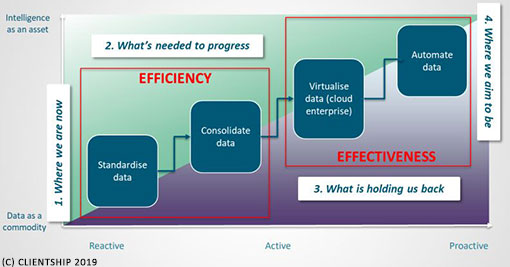
Christopher adds: “How many of us work in organizations where we know some of the data is not correct?”
“If we’re going to be using that data as part of algorithms to send predictive, proactive messages to customers, it is going to get uncomfortable and we may keep getting responses back that say: ‘This is wrong,’ or: ‘This doesn’t help me.’”
3. Failing to Align Your Proactive Messages
A great example of using a proactive message would be to notify a customer when a product that they have viewed multiple times online is on special offer.
This can be a great way to increase revenue and engagement, but only if you do it in the right way. Things can start to go wrong if other messages from your organization are reaching the customer at the same time.
What if the customer also receives a message about an upcoming delivery, a customer survey and an account update, all at the same time – talk about irritating!
If the customer is receiving three or four pop-up messages from your brand a week, they may grow tired of you and send the messages to a spam folder. A good channel for communication is then lost.
So, when creating rules for proactivity, make sure you include all relevant departments in the process, ensuring that you aren’t overwhelming customers and that they only receive the most beneficial alerts.
4. Sending Certain Alerts to Unhappy Customers
We’ve discussed how we can boost revenues by proactively notifying customers of relevant special offers. But how can we be sure that these messages are relevant?
Some customers may already be dissatisfied with our brand and an “annoying” pop-up might send them over the edge and off to a competitor.
So, we want to adjust our proactive customer service model so that overly promotional messages aren’t being sent to “in-danger” customers. Perhaps another type of message would be more appropriate.
Maybe we can instead send the customer a discount and look to reel them back in. But whatever we do, it is good to vary our proactive strategy, by splitting our customers into detractors, passives and promoters or similar groups, based on their satisfaction levels.
3 Examples of How Organizations Are Using Proactive Customer Service Well
While mistakes have no doubt been made, there are many organizations that have been successful in their use of proactive customer service.
Here are three ways in which organizations have been using proactive customer service.
1. Proactive Alerts
When we think about proactivity, for most of us the first thought that enters our mind is those pop-up messages that appear on our phone.
These alerts often appear through customer service apps, SMS messages and email, covering a whole range of topics – whether it’s delivery updates or bank statements.
They can work well when following up with/presenting offers to low-satisfaction customers and better engaging with customers who leave great feedback.
However, even when we are just informing and alerting customers, we should not limit our thinking to just sending proactive messages to our customers’ phones. Let’s think a little outside the box.
For example, when a customer is about to complete a big purchase, but is taking a long time to check out, maybe we can reach out to them with a proactive live chat. This extra support can help to remove any last-minute jitters and increase revenue.
For more on being proactive in customer service, read our article: 7 Ideas for Proactive Customer Service
2. DIY Proactive Service
Let’s not forget that some of these proactive tools can be bought on Amazon for £20 by the customer themselves.
The customer can go out, buy a water monitor, stick it on a pipe and their phone will tell them if there’s a leak. So, we’re already self-serving proactive customer service.

Continuing this example, Christopher says: “You can get very smart with this technology. In the water industry, you can look at pipes and be actively listening to things, such as changes in the water flow.”
“By doing this, the organization has the ability to recognize that the pattern of behaviour is not as it should be, connect that back to data sets and see that this typically is a result of a leak in the area.”
“Then, you can send out a proactive alert to everyone nearby, to inform them in advance that the water will be switched off or that there’s a leak in the area.”
This is an example of something called Remote Asset Monitoring. This involves tracking the condition of certain products, which alert the contact centre when the product needs repairing or replacing.
The contact centre can then send a proactive notification to their customer to inform them that the product needs to be changed. This shows how proactive customer service can spare customers the pain of waiting until something breaks to be repaired/replaced.
3. Eindhoven Airport – A Case Study
Eindhoven Airport has revolutionized its customer journey through proactive notifications, as seen in the video below.
While we have only considered proactivity at certain points in the customer experience, Eindhoven Airport looks to positively influence customer behaviour in three stages.
Stage 1 – “Inform Me”
In the video, the airport demonstrated how they could recommend flights based on the interests of that potential passenger to places that they had never been before.
This is a helpful nudge to the customer, so they begin a journey, based on a clever use of data.
Many companies have reached this stage, but don’t take proactivity any further. But that is certainly not the case with Eindhoven Airport…
Stage 2 – “Adjust Me”
Eindhoven Airport also uses proactivity tools in customer support to tell customers that something has actually changed, so the customer changes what they are doing.
For example, if the flight departs ten minutes later than scheduled, the arrival time of the share car or “Amber” – as discussed in the video – the arrival time of that car will be adjusted automatically.
This is a great example of how we can take away issues from the customer by using data and presenting to the customer what we’ve done for them – to showcase our value.
Stage 3 – “Optimize Me”
This stage is where we can achieve real distinction. In this particular situation, the customer is sitting in the airport and they’ve been told that their flight has a 35-minute delay.
So, through the self-serve app, customers get served with some offers that they can take advantage of during that 35-minute delay.
In the video, the customer decides to take up a restaurant offer and that alerts the restaurant, so they start preparing his food. He goes through security and the food is waiting for him.
All of this is a consequence of a proactive customer service strategy. So, if we really want to stand out, let’s consider how we can take our proposition to this third level.
So, Should You Invest in Proactive Customer Service?
As discussed throughout this article, making the most out of proactive customer service requires a big cultural change. You therefore need to be carefully considering how you value customers.
If you see customers as no more than a transaction or a metric, then potentially you’re not going to get the most value from proactive customer service.
However, if you’re looking to have long-term relationships with your customers, then an activity like proactive customer service will likely pay dividends.
You don’t want customers to misunderstand what you are trying to achieve with proactive customer service, so try and think about where your organization lands on the chart below.
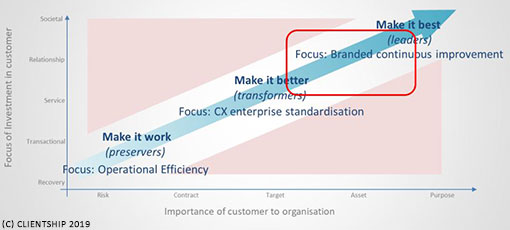
The red box gives you an idea of where you should be if you wish to make the most from proactive customer service and make things as easy as possible for your customers.
Yet one thing to bear in mind is that you may not get any great plaudits for this. Putting a proactive strategy in place doesn’t mean that customers will value and love you for it – but it can be great in terms of differentiation and exceeding customer expectations.
For more on service strategies that will differentiate your organization, read our articles:
- The Top 10 Customer Service Strategies
- 5 Contact Centre Improvement Strategies
- How to Create an Effective Digital Customer Service Strategy
Author: Robyn Coppell
Reviewed by: Megan Jones
Published On: 29th Jan 2020 - Last modified: 23rd Sep 2025
Read more about - Customer Service Strategy, Customer Effort, Customer Journey, Customer Service, Editor's Picks, Service Strategy











